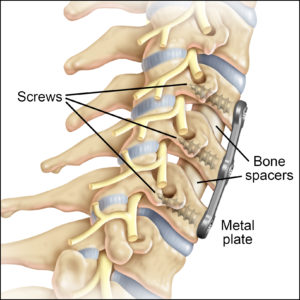One of the most common procedures performed by orthopedic spine surgeons is the Anterior Cervical Discectomy & Fusion (ACDF). This procedure is typically used to treat conditions affecting the cervical spine (neck area) that involve disc herniation or degenerative disc disease. ACDF aims to relieve pressure on the spinal cord or nerve roots and stabilize the affected segment of the spine. Here is an overview of the ACDF procedure:
Procedure Overview:
- Incision: The surgeon makes a small incision on either the right or left side of the neck, which allows access to the cervical spine.
- Discectomy: Using specialized instruments, the surgeon removes the damaged or herniated disc that is causing compression on the spinal cord or nerves. This relieves pressure and alleviates associated symptoms.
- Fusion: After the discectomy, the surgeon creates space between the adjacent vertebrae and inserts a bone graft or a metal or plastic cage to replace the removed disc. This promotes fusion (joining) of the adjacent vertebrae over time, preventing motion between them.
- Stabilization: To enhance stability during the fusion process, the surgeon may use a small plate with screws that are carefully drilled into the vertebral bodies. This hardware helps hold the vertebrae in the correct position while fusion occurs.
- Closure: The surgeon closes the incision using absorbable sutures. In some cases, a drain may be placed to collect any postoperative fluids, which is typically removed before the patient leaves the hospital.
Recovery and Rehabilitation: After an ACDF procedure, patients typically spend one to two nights in the hospital. Pain medications and antibiotics may be administered to manage pain and reduce the risk of infection. Physical therapy is often recommended to aid in recovery and restore strength and mobility to the neck. The specific timeline for recovery varies depending on the individual and the extent of the surgery.
Potential Complications: While ACDF is generally considered safe, it is essential to be aware of potential complications, which can include:
- Inadequate relief of symptoms: In some cases, the surgery may not fully alleviate the symptoms, especially if the underlying cause is more complex or there are multiple affected levels.
- Non-union or pseudarthrosis: Occasionally, the bone graft fails to fuse properly, resulting in a non-union. Factors such as diabetes, smoking, chronic steroid use, or osteoporosis may increase the risk of this complication.
- Nerve damage: There is a slight risk of nerve irritation or damage during surgery, which can lead to temporary or, rarely, permanent changes in voice or swallowing.
- Dural tear: The thin outer layer of the spinal cord, known as the dura, can be torn during the procedure. Surgeons take great care to repair such tears to minimize complications.
- Infection and bleeding: While rare, these complications can occur following any surgical procedure. Precautions such as antibiotic administration and proper wound care help minimize these risks.
- Adjacent segment disease: After fusion, there is a slight risk of degeneration and subsequent issues in adjacent levels of the spine. Some patients may require additional surgery if these problems arise.
It is important to discuss the potential risks and benefits of ACDF with your orthopedic spine surgeon, who can provide personalized guidance based on your specific condition and medical history.
